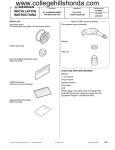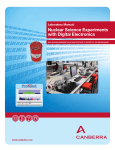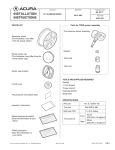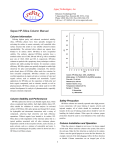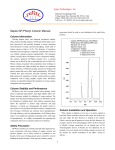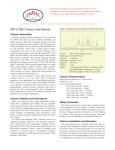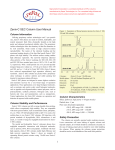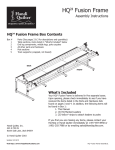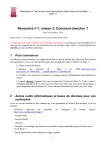Download View the Installation Instructions
Transcript
INSTALLATION INSTRUCTIONS Accessory Application 17” ALUMINUM WHEEL P/N 08W17-SZT-100 2011 CR-Z AII 43550 Issue Date AUG 2010 PARTS LIST Aluminum wheel (The illustration may differ from the actual wheel.) Publications No. Parts for TPMS sensor assembly Tire pressure sensor assembly Washer Wheel center cap Valve nut Tire and loading information label TOOLS AND SUPPLIES REQUIRED Ratchet TPMS Information (Give this to your customer.) 11 mm Socket Torque wrench Isopropyl alcohol Shop towel HDS Universal TPMS sensor reader (AEQVT55) (Available through the Honda Tool and Equipment program. On the iN, click on: Service/Service Bay/Tool and Equipment Program, then enter the number under “Search.” Or call 888-424-6857.) Supplemental information SPECIFICATIONS Rim size 17 x 6 1/2 J (inset 45) Tire size 205/45R17 88Y Bolt hole PCD 114.3 (5 holes) Front 230kPa (2.3 kgf/cm2, 33 psi) Rear 230kPa (2.3 kgf/cm2, 33 psi) Tire pressure © 2010 American Honda Motor Co., Inc. – All Rights Reserved. AII 43550 (1008) 08W17-SZT-1000-91 1 of 5 INSTALLATION 1. Customer Information: The information in this installation instruction is intended for use only by skilled technicians who have the proper tools, equipment, and training to correctly and safely add equipment to your vehicle. These procedures should not be attempted by “do-it-yourselfers.” Before installing the tire pressure sensor, clean the mating surface on the sensor and the aluminum wheel. WASHER GROMMET VALVE NUT NOTE: VALVE STEM • This aluminum wheel is designed for use on a vehicle equipped with TPMS (Tire Pressure Monitoring System). SENSOR HOUSING SURFACE • This aluminum wheel is equipped with a TPMS sensor. See the service manual for tire replacement procedure and TPMS sensor installation procedure. OUTSIDE TIRE PRESSURE SENSOR ASSEMBLY • Install the correct size tire. WHEEL CENTER • Use a tire changer to install and remove the tire. Do not use a tire lever, as it may cause damage to the tire and aluminum wheel. ALUMINUM WHEEL • Do not damage the wheel center cap when installing the emblem. WHEEL PROTRUSION WASHER VALVE NUT Torque to: 4 N·m (3.0 lbf·ft) TIRE PRESSURE SENSOR ASSEMBLY • The wheel nut torque is 108 N·m (80 lbf·ft). VIEW FROM THE INSIDE OF THE ALUMINUM WHEEL SENSOR HOUSING SURFACE 871601AR 2. Remove the valve cap. Install the tire pressure sensor and the washer to the wheel, and fingertighten the valve nut. Make sure the pressure sensor is resting on the wheel. NOTE: Make sure the sensor housing surface does not protrude into the bead area of the wheel. This prevents the sensor housing from being caught on the bead of the tire when installing the tire. 3. Torque the valve nut to: 4 N·m (3.0 lbf·ft) while holding the tire pressure sensor against the wheel. Reinstall the valve cap. NOTE: • Do not reuse torqued grommets; otherwise, the valve system may leak. • Do not use pneumatic or electric tools on the valve nut. • Tightening the nut above the specified torque can damage the grommet. 2 of 5 4. Install the tires according to the instructions in the service manual. 5. Install the wheels on the vehicle and torque the wheel nuts to 108 N·m (80 lbf·ft). AII 43550 (1008) © 2010 American Honda Motor Co., Inc. – All Rights Reserved. 6. Open the driver’s door. Using isopropyl alcohol on a shop towel, thoroughly clean the door jamb where the tire and loading information label will attach. MEMORIZING THE TIRE PRESSURE SENSOR ID 9. DRIVER’S DOOR OPENING Using the HDS and the universal TPMS sensor reader (AEQVT55), memorize each tire pressure sensor ID according to the instructions in the service manual (Memorizing the Tire Pressure Sensor ID). DOOR JAMB TIRE AND LOADING INFORMATION LABEL FRONT Clean with isopropyl alcohol. VEHICLE TIRE INFORMATION LABEL 7. 8. DATA LINK CONNECTOR 022502AB Remove the adhesive backing from the tire and loading information label, and attach it over the vehicle tire information label. HDS 9N2418BB Insert the Supplemental Information page into the owner’s manual. UNIVERSAL TPMS SENSOR READER (AEQVT55) 6912020B 10. Perform the Inch-up Tire Pressure programming procedure as follows. © 2010 American Honda Motor Co., Inc. – All Rights Reserved. AII 43550 (1008) 3 of 5 INCH-UP TIRE PRESSURE PROGRAMMING (LOW AIR PRESSURE WARNING THRESHOLD REPROGRAMMING) 1. After the sensor ID learning using the HDS, back up to the “TPMS Mode Menu,” and click on “Threshold Rewriting.” 2. Select “Reprogramming for accessory tires.” 3. When the HDS says, “Do you want to rewrite the threshold data?” click “YES.” 4. Check that “Please enter the tire information code of new tires” is shown, and click the “Keyboard” icon. 5. Enter the 10-digit tire information code printed on the new tire and loading information label, then click the check icon. 6. Check that the tire pressure shown on HDS, and the new tire pressure on the tire and loading information label are the same, then click the “YES” button. 7. Check that the current air pressure setting shown on HDS is correct and “Reprogramming the threshold data for non-standard tires has completed successfully” is shown. 8. After programming, write the tire pressure indicated on the HDS in the “Service History Page for Honda Accessory Wheels,” then click the check icon. 9. After programming, complete the “Service History Page for Honda Accessory Wheels,” according to the procedure on page 5. NOTE: • After finishing the work, write the tire size, tire pressure, HDS version, dealer name, technician’s signature, and date in “Service History Page for Honda Accessory Alloy Wheels” page included in this kit, and attach it to the vehicle’s service history booklet. • Be sure to explain the contents of the “Supplemental Information” to your customer before delivering the vehicle. • Be sure to give the wheel cleaning information and TPMS information to your customer. 10-DIGIT NUMBER DATA LINK CONNECTOR HDS 4 of 5 9N2418BB AII 43550 (1008) TIRE AND LOADING INFORMATION LABEL 7125550B © 2010 American Honda Motor Co., Inc. – All Rights Reserved. REINSTALLING STANDARD WHEELS THRESHOLD DATA CHECK If the original equipment (standard) wheels are reinstalled on the vehicle, the low tire pressure warning threshold must be restored to the factory setting, follow the procedure below. If you are unsure where the low tire pressure warning threshold is set, do the following: 1. Connect the HDS to the vehicle, and make sure the correct VIN is populated, and enter the mileage. NOTE: Have the standard tire pressure label on hand. 2. At the “System Selection Menu,” click “TPMS.” TPMS UNIT REPLACEMENT 3. Click on “Threshold Rewriting.” If the TPMS unit is replaced, redo the Inch-up Tire Pressure Programming and Tire Pressure ID Memorization. 4. Click on “Threshold Data Check.” STANDARD TIRE PRESSURE PROGRAMMING To return the TPMS programming from the inch-up tire to the standard tire, change the programming: 1. Connect the HDS to the vehicle, make sure the correct VIN is populated, and enter the mileage. 2. At the “System Selection Menu,” click “TPMS.” 3. At the “Mode Menu,” click on “DTCs” and clear any stored codes. 4. Go back to the “Mode Menu,” and click on “Threshold Rewriting.” 5. Click on “Reprogramming for standard tires,” and follow the screen prompts. 6. After programming, write the standard tire pressure in the Supplemental Information page, then click the check button. 7. Attach the standard tire pressure information label over the old label in the driver’s doorjamb. 8. Sign the “Service History Page for Honda Accessory Wheels.” DATA LINK CONNECTOR HDS 9N2418BB Write the tire size, tire pressure, HDS version, dealer name, technician’s signature and date in the “Service History Page for Honda Accessory Wheels.” © 2010 American Honda Motor Co., Inc. – All Rights Reserved. AII 43550 (1008) 5 of 5





